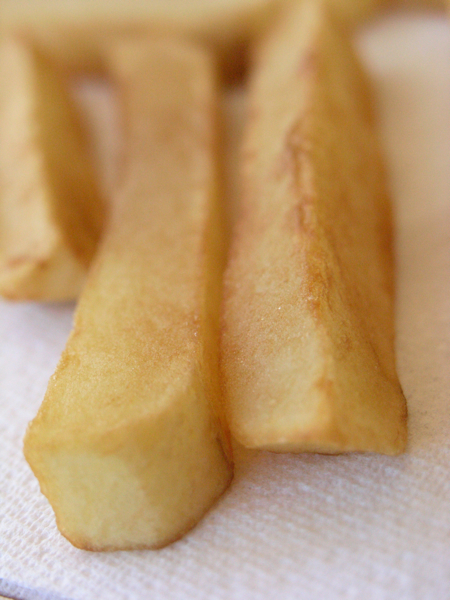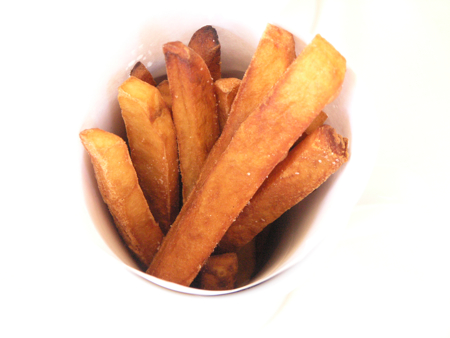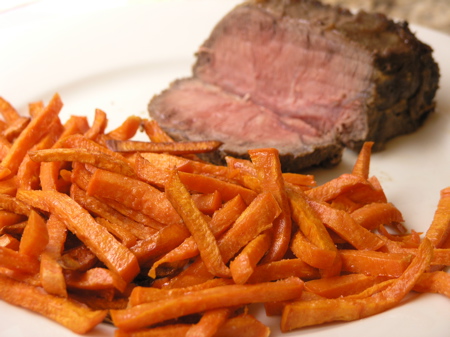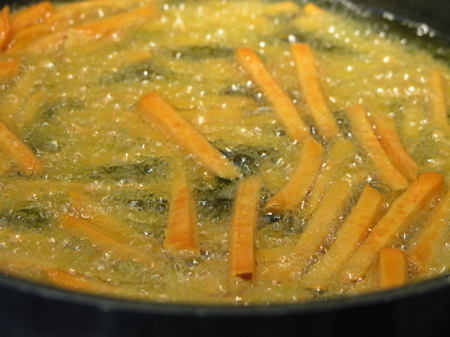[pinterest]

For over 80 years, the Thrasher’s French Fries stand at 401 South Atlantic Avenue, in Ocean City, MD, has served as a kind of gatekeeper to the famous boardwalk. At Thrasher’s, the potatoes are cut fresh, fried twice, doused with vinegar, and served in buckets. Big buckets. With only three sizes available (16 oz, 32 oz and 53 oz buckets), the smallest serving you can buy is a pound. But, there is something about these fries that makes them so addictive that a pound often is not enough and Thrasher’s fans are adamant. These are the best fries on the planet.

With more than eight decades of frying and over 22,000 fans of the unofficial facebook page, who’s to argue? In 1933, Thrasher’s weathered a hurricane that not only destroyed vast sections of the boardwalk, but actually severed off Assateague peninsula to create the now-famous Assateague island across the inlet. Thrasher’s then went on to survive the Great Depression, two World Wars, Reaganomics, and the “freedom fries” era. Featured in countless magazine and newspaper articles, like the Woman’s Day 8 Best Boardwalk Food in the U.S., and inevitably found in the comments section of any web article about the “best fries,” these fries inspire a fanaticism usually reserved for politics and religion.
So, when I was heading back to my native Maryland Eastern Shore, I knew that it was time to make a pilgrimage to the place where I first learned what a French fry is supposed to taste like. Sure enough, there is something irresistible about these fries. They aren’t particularly crispy, but the flavor is pure potato. In fact, Thrasher’s is so proud of the fresh potato flavor, they don’t provide (or even allow) ketchup.

Katherine Bunting-Howarth of Delaware remembers using so much vinegar once, she soaked a hole through the bottom of the bucket and she’s not the only who considers the vinegar to be an essential element of the Thrasher’s experience. 939 people on facebook have “liked” the Thrasher’s facebook update, “[…] diggin’ the Apple Cider Vinegar with no ketchup!” and dozens more have added their two cents.”
After returning to California, more than 3000 miles away, I began to wonder. Can I recreate true Thrasher’s French Fries at home? I know the basic ingredients: Russet potatoes, peanut oil, salt and vinegar. But can I get that same balance of tender and crispy? And can I reproduce the rich, potato flavor? I set out to find the answer. But it would not come directly from the source. Thrasher’s is part of the Bayshore Development Corporation which also owns the Jolly Roger amusement parks. My attempts to reach someone at Bayshore willing to talk about Thrashers Fries were unsuccessful. Buddy Jenkins, chair of the board of the Bayshore Development Corporation, has always been secretive about the magic of these fries. According to a 2004 Washington Post article, Jenkins said, “We have a process that I certainly don’t intend to divulge,” but that the secret involves a “recipe and cooking times.”
Well, a recipe and cooking times were just what I set out to develop. I knew that part of what makes boardwalk fries, boardwalk fries is that they are soaked in a brine solution before they are fried twice, so I knew that I would try brining the potatoes as part of the solution. But how hot should the oil be? How long should the fries, well, fry? To find some answers, I turned to The Food Lab at SeriousEats.com. In May, J. Kenji Lopez-Alt set out to determine what makes a McDonald’s french fry so darn good and I have applied some of his learnings to this project. But Thrasher’s French Fries are not like McDonad’s French Fries. They’re thicker for one thing, and they’re served in buckets; they’re never frozen, and, must I say it again? They’re eaten with vinegar, not ketchup. But, they do need to come out with a crispy exterior and a fluffy, fully-cooked interior and that is where the “recipe and cooking times” come in. In his article, Lopez-Alt discovers that McDonald’s actually blanches its fries in nearly-boiling water before frying them, so I decided to add this step to my process as well. Blanching them at 170˚F rinses off excess sugars and starch which in turn prevents over-browning later. It also strengthens the cell walls of the potato so it doesn’t completely lose its structure during the frying process. Again, Lopez-Alt explains all of this really well here.
Following the multi-step process of brining, blanching, frying, cooling, frying meant that I could enjoy something approaching a bucket of Thrasher’s French Fries without having to leave the state of California. And that, my friends, is worth a day’s effort. Are you with me on this one? If you are, read on for the complete recipe.

My best attempt at recreating
Thrasher’s French Fries at Home
Serves 2 (or one, really)
Ingredients
4 Russet potatoes, peeled and sliced into 3/4-inch thick slices
Peanut Oil, enough for fries to be submerged
Sea Salt
Apple Cider Vinegar (or malt vinegar, if you prefer)
For the brine
2 quarts water
1 cup salt
Tools
I don’t have a lot of deep-frying tools in my kitchen. No wire basket, no electric fryer. But the one instrument that is indispensable for this recipe is a Candy/Deep Fry Thermometer, like the one pictured here:

Method
1. Mix the water and salt in a large glass bowl. Stir to dissolve salt. Add potato slices and allow to sit for 30 minutes. Drain in a colander and rinse.
2. In a large stock pot over medium heat, bring a bath of water to 170˚F. Remember, the boiling point of water is 212˚F, so you don’t want to let it boil. There will just be a few bubbles. Add the potatoes and let them sit in this warm bath for 17 minutes. Continue to check the temperature periodically to ensure that you are spot on. Remove potato slices to a paper towel-lined cutting board or cookie sheet and allow them to dry. They must be completely dry before submerging them in the hot oil, so do what you need to do to ensure that they are dry.
3. In a dutch oven or heavy-bottom pot, heat the peanut oil to a whopping 400˚F. Beware. Hot oil is hot. Wear protective clothing and make sure you do not allow any drop of water to fall into the hot oil bath. It will splatter and burn you. Don’t ask me how I know this. Carefully lower about 1/3 of the potato slices into the oil and allow them to fry for 80 seconds. Make sure they are not sticking to each other during this process. If you notice them starting to turn brown, remove them immediately. During this stage of the process, they should only just begin to take on a golden color. Remove them to a paper-towel lined surface and repeat with two more batches. Allow the oil to come back to the proper temperature between batches. This is what they look like after the first frying session:

4. Allow the fries to cool for at least 30 minutes. Then, bring the oil back up to a temperature of 375˚F. Again, in batches, allow the fries to cook for 3 – 4 minutes. Watch carefully so that they don’t get too brown. Remove them to a paper-toweled lined surface and salt immediately. They can be kept warm in a 200˚F oven on a parchment-lined cookie sheet while you are frying the other batches, but I found it wasn’t necessary because everything moved so fast.
5. Serve in paper-lined cups (I used tall coffee cups) and sprinkle with salt and, of course, cider vinegar! Enjoy immediately.

What are your memories of Thrasher’s French Fries? What tips do you have for making the best fries at home? What boardwalk food do you love the best? Share your memories, tips and opinions in the comment section below.
If you liked this article, please become click “like” on StreamingGourmet facebook fan page.
For great cooking videos like this one introducing you to French fry techniques, check out Rouxbe.com:

















